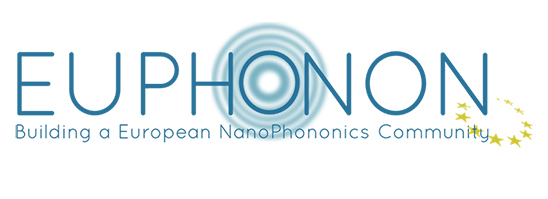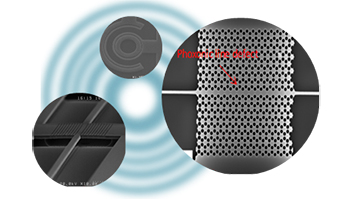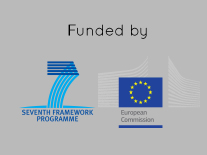 |

|
 |
| CNRS |
 |
|
 |
 |
 |
The Laboratoire d’Energétique Moléculaire et Macroscopique, Combustion, (UPR CNRS 288) involves world leading teams in the fields of Combustion and Transport Physics. Among those latter teams, the Thermal NanoSciences group headed by Sebastian Volz has developed a long-term expertise in the field of Nanoscale Heat Transfer in terms of physical computational modelling at macro-to-nanoscales. This covers phonon heat conduction in nanostructures and nanomaterials as well as near field radiation. In parallel, this group also proposed new nanoscale thermal metrologies based on Scanning Thermal Microscopy. More recently, thermoelectric and thermal interface materials are under focus.
The CNRS team will ensure the global management and the coordination of EUPHONON. It is also involved in the four other WPs as supporting team.
|
 |
 |
|
|
 |
 |
|
|
 |
 |
| ICN2 |
 |
|
 |
 |
 |
Catalan Institute of Nanoscience and Nanotechnology (ICN2) (www.icn.cat) is a research centre of the Generalitat de Catalunya. ICN2 has about 90 researchers. The 15- strong Photonic and Phononic Nanostructures (P2N) group (www.icn.cat/~p2n) is led by Prof. Clivia M. Sotomayor Torres and works on nanophononics (phonon confinement, nanoscale heat transport and phononic crystals in semiconductor, organic and oxide nanostructures). The group is constantly developing novel approaches and methods for nano-scale device-relevant research. It has pioneered research in nanofabrication (nanoimprint lithography, self-assembly and others) to realise 3D nanostructures.
|
 |
 |
|
|
 |
 |
|
|
 |
 |
| VTT |
 |
|
 |
 |
 |
VTT Microsystems and Nanoelectronics is part of the VTT Technical Research Centre of Finland (Teknologian tutkimuskeskus VTT), a national research institute with about 3000 employees. The group is active in IC fabrication, MEMS, radiation detectors, thin films, RF-technologies, superconductors, nanoelectronics, nanophotonics, nanophononics and nanobioelectronics. The facilities include a 1900 square meter clean room of which 550 square meters is of class 10, equipped with 150 mm wafer processing line for BiCMOS and MEMS devices, thin film devices, nanoelectronics and micro and nanophotonics, wafer bonding, thinning and polishing processes, flipchip bonding and packaging. e-beam lithography up to 200 mm wafers, ALD, graphene CVD and nanoimprinting lithography. Transport measurements can be performed down to 0.01 K and up to 11 T. RF measurements (up to 110 GHz). Other characterisation tools include AFM, conducting AFM and HRSEM. The setup for optical characterisation include kits for telecom wavelengths and white continuums for visible and IR and stepping con-focal Raman system. Part of the clean room facility is used for small-scale production of CMOS, MEMS and SQUID devices. The permanent staff of VTT Microsystems and Nanoelectronics is 58.
|
 |
 |
|
|
 |
 |
|
|
 |
 |
| LEMANS |
 |
|
 |
 |
 |
The University of Le Mans is a general University. Its expertise in the field of Acoustics and Phonons Science is well established. The Photoinduced-Dynamicsin-Condensed-Matter Group (DPMC) of the Institute of Molecules and Materials at Université du Le Mans (UMR CNRS 6283) is composed of 7 permanent professors and researchers (over 100 members in the whole institute). The group has a long-standing experience in ultrafast acoustics and optoacoustics. The scientific interests include fundamentals of laser-matter interaction and applied ultrafast acoustics aiming at controlling the photogeneration of coherent acoustic phonons by ultrafast light (photonphonon and electron-phonon coupling physics). Acoustic nanowaves are used for directly probing the elasticity of nanostructures (studying acoustic eigenmodes of nanostructures, nanorheology, etc.). Colloids, semiconductors, nanoporous, confined liquids and correlated oxides are the systems currently under investigation. In the last ten years the DPMC group has hosted a number of national and international students for the realization of their Master degrees and their PhD.
|
 |
 |
|
|
 |
 |
|
|
 |
 |
| MPG |
 |
|
 |
 |
 |
The Max Planck Institute for Polymer Research (MPIP) of the Max Planck Society (MPG) is one of the world leading research centres in the field of soft matter, polymer and materials science. At the beginning of 2012, a total of 502 persons work at the MPGP, of which 179 are scientists, 149 are graduate and undergraduate students. MPGP combines all the necessary expertise, from the creative design of new materials and synthesis, to their physical characterization and theoretical modelling. The Institute is divided into six working areas of basic scientific research in soft matter: structure and dynamics, surfaces and interfaces, functional materials and devices, synthesis, development of methods, and supramolecular architectures. The Research Group for Nanostructures and Transport (http://www.MPGp-mainz.mpg.de/~donadio), led by Dr. Davide Donadio, performs theoretical and computational research on the growth and aggregation mechanisms of nanostructures and nano-structured materials, and on their electronic and thermal transport properties. The group current focus is on assembly and thermal transport in carbon- and silicon-based nanostructures for electronic and thermoelectric applications. To this aim atomistic simulations, mostly based on molecular dynamics are performed and problem-inspired methodological development is undertaken.
|
 |
 |
|
|
 |
 |
|
|
 |
 |
| Universitaet Konstanz |
 |
|
 |
 |
 |
Konstanz University is a strongly research oriented university. The Dept. of Physics is focussed on the physics of nanostructures, mesoscopic systems and nanotransport both in theory and experiment. In total 10 professors are working in these areas. The Collaborative Research Center 767 (SFB 767) of the German Research Society Controlled Nanosystems:Interaction and Interfacing to the Macroscale engages the Depts. of Physics and Chemistry (running funding period from 2012-2015) and is one of the largest clusters on nanophysics at a German university. The Modern Optics and Photonics group (Prof. Thomas Dekorsy), part of the Dept. of Physics, is specialized in time-resolved femtosecond spectroscopy of coherent phonon excitation processes in different material systems and their nanostructures. The Nanomechanics group (Prof. Eva Weig) focusses on cavity nano-opto- and electromechanics, the origins of dissipation in nanomechanical systems, and integrated transduction schemes.
|
 |
 |
|
|
 |
 |
|
|
 |
 |
| Phantoms Foundation |
 |
|
 |
 |
 |
The Phantoms Foundation was established in 2002 (Madrid, Spain) in order to provide high level Management profile to scientific projects. The Phantoms Foundation focuses its activities on NanoScience & Nanotechnology (N&N) and is a key actor in structuring and fostering European Excellence and enhancing collaborations in this field.
|
 |
 |
|
|
 |
|
 |
|
























